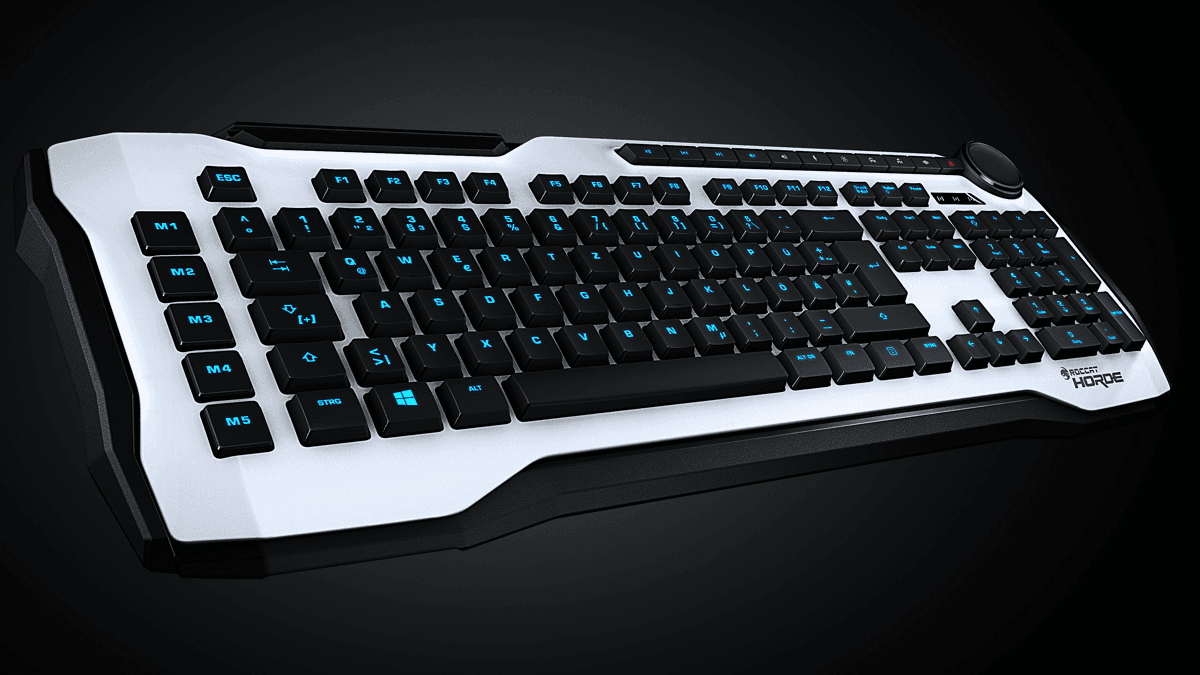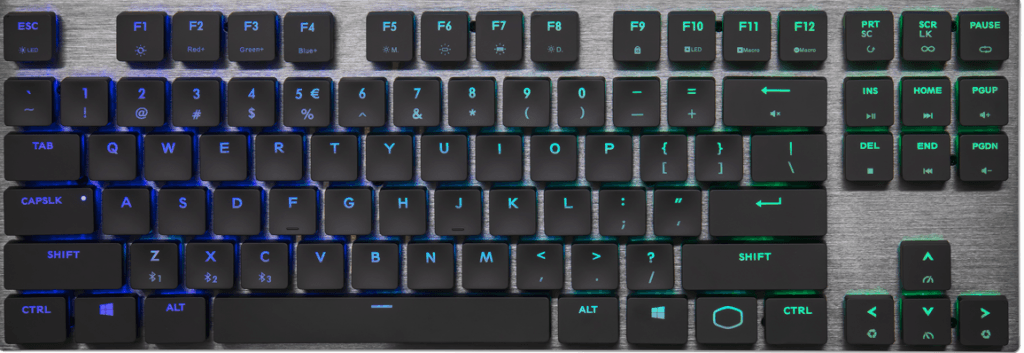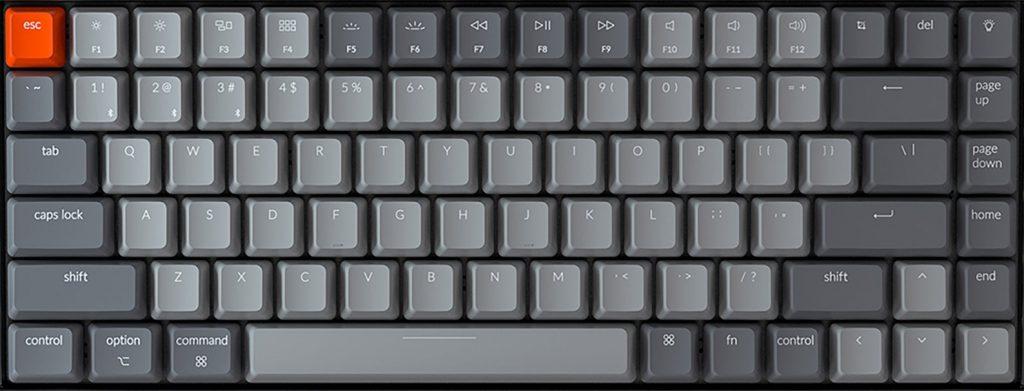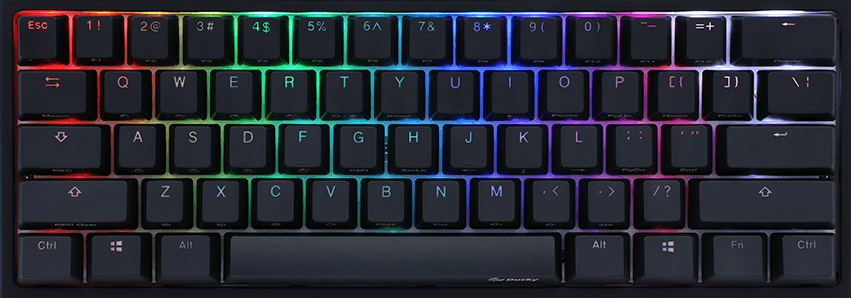Keyboard Sizes: Reference Guide
Have you ever wondered how many keyboard sizes there really are and which keyboard size is right for you? In this article, we’ll introduce each size and show you what’s great or not so great about them.
The fact is, there are many different keyboard sizes and layouts, but how do you tell the difference between them all? The most common keyboard sizes are the standard full layout (104 keys), TKL (87 keys) and 60% (68 keys). Each keyboard size is unique with different features and the smaller the keyboard gets, the more elements are left out. So, let’s take a look at what’s available so you can find the perfect keyboard size for you.
Full-Sized Keyboard (100%)
The best known layout for keyboards is the standard 100% size with 104 keys. At this size, you’ll find the full numeric keypad, F keys, arrow keys, as well as the special keys above it.
Full size keyboards are the first choice for people who need to enter data frequently and often use the number pad. They are also ideal for anyone who needs a versatile selection of keys, whether for gaming, working, or simply surfing the web. Due to the large number of keys, they naturally offer the most options for advanced key mapping via macros. In addition, it’s easy to type on them, since none of the keys except the standard keys are on a lower level and the spacing between the keys is standardized.

Especially with this keyboard size, there are a lot of different designs and dimensions. If you’re looking for unique features and interesting designs, these are usually the models to consider. As you can see from the picture above, the keyboard is 100% model. Nevertheless, the ROCCAT model has so-called macro keys on the left side, which are not standard and make it even wider.
It’s also important to keep in mind that full-size mechanical keyboards can be a bit more expensive than smaller sizes. The main advantage of this size is the large product selection, as it is by far the most popular keyboard size and probably the best-selling as well. Nevertheless, this size is really only worth it if you use the numpad as well. This is because smaller keyboards often give you better ergonomics when typing.
1800 Compact Keyboards (96%)
1800 Compact keyboards are a rather unusual and rare layout that packs as many keys as possible into a small space. They resemble standard full-size keyboards, but save the empty spaces between the number pad, arrow keys and the keys above. Ergo, you get the same number of keys here, but without the separators, making the case a bit more compact. A 96% keyboard offers the same advantages of a standard keyboard, but with a slightly less clunky frame.

Again, there are variations in dimensions, but a more common form of the compact 1800 form factor is the one with deep-set arrow keys and the slightly narrower number pad.
If you don’t want to give up your number pad, then the compact 1800 layout is the smallest keyboard size available to you. Many therefore find this size ideal, but there are very few models on the market. Examples of this type of keyboard are the Keychron K4 or the Cherry G80-1800.
Tenkeyless (TKL) Keyboards (80%)
It’s slowly becoming more compact. We think this keyboard size is ideal for many of you. Tenkeyless keyboards usually have 87 keys, creating the perfect layout to balance size and functionality.

TKL stands for Tenkeyless, but you’ll actually have 17 fewer keys. Imagine simply cutting off the number pad to the right of the arrow keys – then you get a TKL keyboard. This makes the keyboard more compact and easier to carry around. Many of us don’t use the number pad that often anyway, so you hardly lose any functionality.
A more compact keyboard also allows for more desk space, so you have more room on both sides – especially for your mouse. Plus, the mouse is much closer to your mouse hand when you’re typing, so you’ll have shorter distances to reach for it. In addition, Tenkeyless keyboards still have the arrow keys, home cluster and function keys, so you can still play and type comfortably.
Furthermore, the range of TKL keyboards is quite good, especially since many manufacturers often offer such a variant in addition to the standard size due to its popularity. This keyboard size is often considered the perfect compromise between comfort and usable keys. Not only do you get much more room for mouse movement, but you can also angle your keyboard. This gives you a more comfortable hand position, and the letter part is also more centered when typing, which offers ergonomic advantages.
75% Keyboards
An even more compact TKL version can be found at 75% keyboards. This keyboard size is also quite rare and the selection of models is small. 75% keyboards have an interesting design, especially since they place the arrow keys and the block above them directly next to each other. This puts both blocks on edge to save space, which is why all keys are very close to each other. The bottom row to the right of the space bar is also reduced in size, and the shift key is also smaller to make room for the arrow keys.

You will find this keyboard size with 84 keys, for example the Keychron K2. It can take some time to get used to the strange key sizes and placements here. The look may not appeal to everyone, and modders will often have a hard time finding suitable keycaps for this size.
65% Keyboards
The next smaller size is a 65% keyboard, which has the same layout as the 75% keyboard, but additionally omits the F keys. This makes it even smaller in depth and the function line is now integrated into the number line. Some layouts also omit the key block around the DEL key, but this is the smallest keyboard size that still has arrow keys.

The main advantage of a 65% keyboard is that it’s a perfect addition to your laptop. It can be quickly packed into your backpack, or give you even more room for your mouse movements in fast-paced shooter games. On the other hand, the disadvantage is that you have to use the FN key for secondary commands like the F-keys or anything else. Also, replacing keycaps for these smaller, non-standard layouts is a challenge because the secondary controls are not all the same. The bottom row of keys is non-standard on most models, especially to the right of the space bar.
60% Keyboards
Even smaller is possible with 60% keyboards. Here, the arrow keys, F keys and the Del block are removed and can only be controlled via the FN key in secondary function. It will definitely take some time to get used to this. If you rarely to never use these keys anyway, then you can still do some excellent gaming with these mini keyboards.

This form factor is also quite popular since the keycap layout is mostly standardized. Because of their small, compact, and symmetrical shape, this size is also most common for custom brand keyboard designs. Because of their small size, it can also be relatively inexpensive to purchase switches and keycaps for custom designs. There are also a variety of different PCB layouts and case designs specifically for 60% keyboards. You can also find pretty good deals on pre-built mechanical keyboards if you’re willing to switch to the 60% keyboard size.
The biggest advantage, of course, is the even smaller size of the keyboard, which gives you maximum freedom for your mouse movements. However, if you do a lot of word processing or often use Excel with the keyboard, then we would advise against this size. After all, the loss of the ARROW, DELETE, and F keys just isn’t worth it compared to the 65% size. For some, it won’t make a difference, but be sure to consider this point before trying a buy a 60% model.
40% Keyboard
40% keyboards are stripped down to the bare minimum so you can still type on them reasonably. In addition to everything removed from 60% keyboards (no number pad, function bar, arrow keys, home cluster), 40% keyboards also remove all the numbers in the top row. There are no numbers on this keyboard size! Furthermore, you will also look in vain for all special characters like colon or quotation marks.
If you want to type quickly on a 40% keyboard, you will have to get used to typing numbers and symbols. This takes a lot of getting used to, but it saves you a lot of desk space and gives you a light and compact keyboard for on the go.
There’s no question that this form factor is enormously exotic and very hard to find. These keyboards are almost always only home-made, because there are not many models from the common manufacturers. Currently there is low demand for this size. So if you want a 40% keyboard, you’ll want to buy the parts online and assemble them yourself.
Separate Number Pad
No keyboard size anymore, but mentioned for the sake of completeness. Single number blocks usually come with 17 keys and have the same layout as a normal standard keyboard. You can buy number pads separately if you don’t want a full size keyboard. This way you can use the number pad on both sides of your keyboard, which makes data entry more efficient and comfortable.
Also, for games that don’t require a full keyboard, you can use a separate num pad instead and save space.
Why are compact keyboards so popular?
If the desk is big enough and the keyboard is always in the same place, it seems unnecessary at first glance to forgo features in favor of size. However, the preference for small gaming keyboards doesn’t come from desks that are too small, but mainly from the possibility of better positioning.
The smaller the keyboard, the more flexible it can be positioned. With a large keyboard, on the other hand, you are often in your own way and certain keys are then difficult to reach. In addition to better positioning, a small keyboard also offers other advantages:
- Ergonomics: with a small keyboard, the mouse can be guided close to the body. This is in line with natural posture and can help avoid fatigue and prevent health problems.
- Easy to Carry: Not relevant for everyone, but a big advantage if you actually want to be mobile. Besides small pack size and low weight, small mechanical keyboards usually always have a detachable cable.
- Favorable Price: If there are several variants of a keyboard to choose from, the small keyboards are usually cheaper than the standard-sized keyboard.
- Small Space Requirement: A small keyboard creates more space on the table for other things. However, there is no obligation to necessarily fill up the table.
Why does the Size of your Keyboard Matter?
The keyboard size should be perfectly suited to your needs. There are many factors to consider when choosing the layout that works best for you.
- Do you often want to take your keyboard with you? Then it should be as small, light and portable as possible. In general, a TKL keyboard and smaller is ideal for traveling. Anything larger quickly becomes bulky and unwieldy.
- If you’re buying your keyboard exclusively for your desk, then you might as well go for the full size. Just be aware of which functions and keys you really need.
- Anyone considering a smaller keyboard layout like 65% or less should keep the learning curve in mind. For example, with a 60% keyboard, you first have to learn how to get by without arrow keys. The smaller the keyboard gets, the more you’ll have to learn and work with FN shortcuts.
- In our experience, the TKL-65% ranges are ideal. Anything below that gets weird, especially if the arrow keys are missing it gets extremely weird and awkward. If you feel like it, you can of course build your own keyboard.
The following table summarizes the most important differences between the keyboard sizes:
| Keyboard Size | # of Keys | Number Pad | Home Cluster | Function Row | Arrow Keys | Number Keys |
|---|---|---|---|---|---|---|
| Full-Sized (100%) | 104 | ✔ | ✔ | ✔ | ✔ | ✔ |
| 1800 Compact | 103-104 | ✔ | ✔ | ✔ | ✔ | ✔ |
| TKL (80%) | 87 | ❌ | ✔ | ✔ | ✔ | ✔ |
| 75% | 80-84 | ❌ | ✔ | ✔ | ✔ | ✔ |
| 65% | 66-69 | ❌ | ✔ | ❌ | ✔ | ✔ |
| 60% | 58-65 | ❌ | ❌ | ❌ | ✔ | ✔ |
| 40% | 40-44 | ❌ | ❌ | ❌ | ❌ | ❌ |
| Number Pad | 17 | ✔ | ❌ | ❌ | ❌ | ❌ |
And with that, we have explained all the important keyboard sizes. For most of you, the ideal keyboard size will be somewhere in the middle, but you generally can’t go wrong with a TKL. Especially for gamers, TKL models are a good balance between compactness and functionality. With anything smaller, you have to adjust somehow.
FAQs regarding Keyboard Sizes
What do you have to look out for before buying?
Even if the old keyboard that came with the last PC may still work: The right keyboard can not only make working on the PC easier, but also prevent signs of fatigue or even pain in the hand. However, there is no such thing as the perfect keyboard. No keyboard can cover all needs equally well, so a willingness to compromise is required. Everyone has different demands and a different understanding of a perfect keyboard. Which keys and which material one finds pleasant can differ completely from user to user. The more wishes you have for a keyboard, the higher the price will be in the end.
The first thing to do is to decide on a keyboard type. Should the keys be flat like on a notebook or high like on a conventional keyboard? Should the keystroke be light or rather heavy? Does the keyboard have to be quiet? Do you need extras like multimedia buttons to control video and audio players or programmable keys? These are essential questions that you should ask yourself before buying a keyboard. Furthermore, the area of use is of course important: Do you write a lot or mainly play games? Should the keyboard be wired or wireless? But the individual typing behavior is also of crucial importance. For example, if the numeric keypad is often used, the new keyboard should also have one.
Ideally, you should try out different keyboard types from different manufacturers and with different key technologies to find the optimal type for yourself. Another very important factor for keyboards is the pressure point of the keys. Often, only after buying a keyboard do you realize that everything actually fits, but a good typing feeling just doesn’t want to arise due to the unfamiliar and perhaps poor pressure point. Here, it is important to test whether the pressure point is pleasant for writing or suitable for everyday use before buying.
Especially normal users and frequent writers usually place a lot of value on a good keystroke. Others, on the other hand, favor a keyboard with macro functions, i.e. programmable keys that can save a lot of time in more complex applications, such as image editing or 3D programs. Depending on the model, this can be set via driver or directly in the hardware. Gamers can also benefit from macro keys, for example when they use several commands on one key in strategy games. Gamers also attach great importance to the so-called anti-ghosting. This function allows pressing or processing several keys at the same time, which is not possible with normal keyboards.
Other features of keyboards are palm rests for better ergonomics, replaceable keycaps, backlighting of the keys or a USB hub function.
What technology is under the key?
The technology underneath the key is crucial for the stroke and key pressure. The keyboards that come with complete PCs usually rely on the favorable membrane technology. Here, a kind of rubber nipple is inserted underneath the key, which presses two conductive foils on top of each other together when the key is pressed and at the same time provides a usually quite spongy counter-pressure, i.e. the stroke. Depending on the nature of the rubber, the key is then harder or easier to press, while the stroke is usually relatively long. Since this technique is very simple, it is mostly used in inexpensive keyboards. Advantage is very quiet typing without annoying clicking. Big disadvantage is durability, which is not exactly high due to wear. It is possible that frequently used keys like the “E” or the space bar have already worn out after a few months and can no longer be pressed properly.
The so-called scissor technology for keys is a bit more robust. Here, the stroke is very short. Therefore, this technology is mostly used for notebook keyboards and desktop models with flat keys. The key stroke is very pleasant and the typist gets a good feedback, while typing is usually quiet. Mechanical keys from the manufacturer Cherry are increasingly used in more expensive keyboards. Here, too, the stroke is very long, similar to the membrane technology. However, mechanical keys hardly wear out – manufacturers promise 20 to 50 million strokes. Cherry also offers a choice of four different switch variants for the mechanical MX switches: Brown, for a similar pressure point to membrane keyboards – so relatively soft and quiet. The blue MX switches are even easier to press, but offer both an acoustic click and a haptic signal when pressed, as if the key is dropping. In addition, there are the red and black MX switches, which can be pressed continuously, but differ a bit in resistance and do their job with a quiet click. Gamers in particular, but also frequent typists, like to use keyboards with Cherry MX keys.